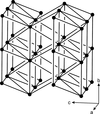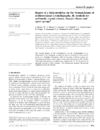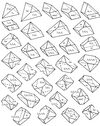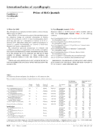issue contents
November 2002 issue

Cover illustration: Electrostatic equilibrium of simultaneous Coulomb attraction and core repulsion for an ensemble ![]() ; the conjoint centroids, shown in yellow, characterize force-free positions of the fragment inside the unit cell. For comparison, the pure Coulomb equilibrium is shown in the background. See Mädler, Behrends & Knorr [Acta Cryst. (2001). A57, 20-23].
; the conjoint centroids, shown in yellow, characterize force-free positions of the fragment inside the unit cell. For comparison, the pure Coulomb equilibrium is shown in the background. See Mädler, Behrends & Knorr [Acta Cryst. (2001). A57, 20-23].
research papers
 access
access
short communications
international union of crystallography



 journal menu
journal menu

































